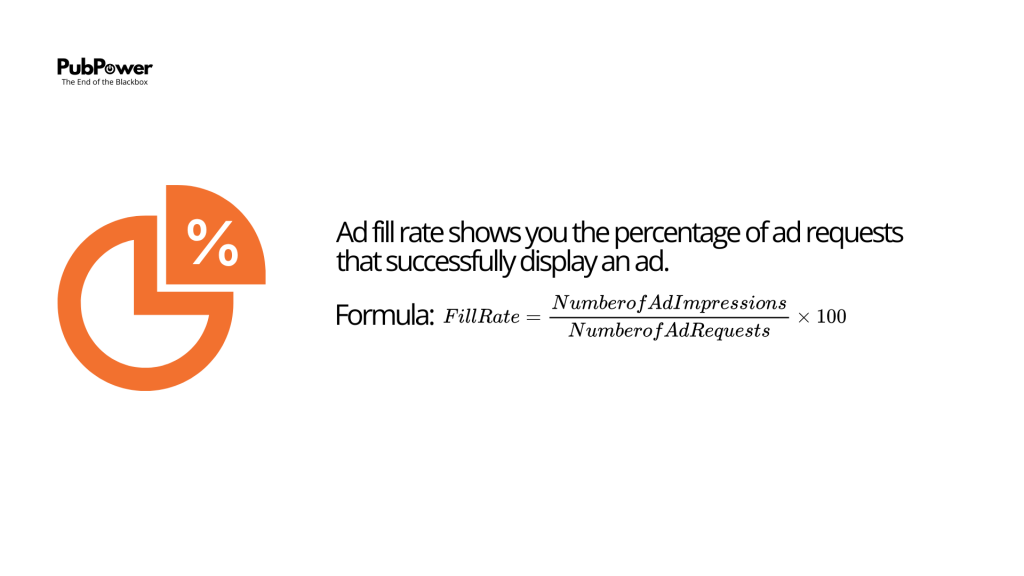Running a website or app means turning every visitor into revenue, but if your ads aren’t showing up consistently, you’re literally watching money disappear. Ad fill rate is your reality check—a simple metric that reveals how efficiently your ad inventory is actually working.
This guide cuts through the complexity with clear explanations and actionable strategies. After helping publishers optimize their ad performance for over a decade, we’ve seen how small fill rate improvements can unlock substantial revenue growth. Let’s explore what matters most for your bottom line.
Contents
- 1 What is Ad Fill Rate?
- 2 Why Ad Fill Rate Directly Impacts Your Success
- 3 Key Factors That Make or Break Your Fill Rate
- 4 Is 100% Ad Fill Rate Possible (or Even Desirable)?
- 5 Proven Strategies to Boost Your Ad Fill Rate
- 5.1 1. Optimize Placement Strategy
- 5.2 2. Implement Header Bidding
- 5.3 3. Dynamic Floor Price Management
- 5.4 4. Expand Geographic Targeting
- 5.5 5. Diversify Demand Sources
- 5.6 6. Implement Smart Frequency Capping
- 5.7 7. Technical Performance Optimization
- 5.8 8. Capitalize on Seasonal Demand
- 5.9 9. Regular Performance Analysis
- 6 How PubPower Enhances Your Fill Rate Strategy
- 7 Frequently Asked Questions
- 8 Take Action on Your Ad Fill Rate Today
What is Ad Fill Rate?
Ad fill rate shows you the percentage of ad requests that successfully display an ad. Think of it as your conversion rate for ad inventory—every empty ad slot is a missed opportunity.
Here’s the simple formula:
Ad Fill Rate (%) = (Number of Ad Impressions ÷ Number of Ad Requests) × 100
Breaking it down:
- Ad requests: Every time your site asks ad networks for an ad
- Ad impressions: The ads that actually load and display

Real-world example: Your site generates 10,000 ad requests today, but only 7,000 show ads. That’s a 70% fill rate, meaning 30% of your inventory went unused.
This applies across all ad formats—display, video, native—and serves as your early warning system for revenue leaks. According to PubMatic’s 2023 research, publishers maintaining fill rates above 80% consistently earn 6-15% more than those struggling below 70%.
Why Ad Fill Rate Directly Impacts Your Success
A strong fill rate isn’t just about filling empty spaces—it’s about building predictable revenue while maintaining user experience. Here’s why it matters:
Immediate Revenue Impact
Empty ad slots generate zero income, period. With Siteefy reporting 175 new websites launching every minute, competition for advertiser budgets intensifies daily. Higher fill rates help you capture more of that available spend.
Enhanced User Experience
Blank ad spaces create an unpolished, incomplete feeling that can increase bounce rates. Well-filled ad inventory, when thoughtfully implemented, maintains site flow and keeps visitors engaged longer.
Improved Ad Quality
Consistently filled slots attract higher-quality bids from advertisers, driving up your eCPM. In our experience, publishers who ignore fill rates often plateau in their growth. But those who optimize strategically? We’ve watched sites double their ad revenue within months by addressing fill rate gaps early.
Key Factors That Make or Break Your Fill Rate
Fill rates don’t fluctuate randomly. Understanding these core factors helps you diagnose issues and implement targeted fixes.
Market Dynamics
Geographic Location: Advertisers heavily favor high-value regions like the US and Western Europe. Publishers in emerging markets typically see 20-30% lower fill rates due to reduced demand (Publift analysis).
Seasonal Patterns: Demand surges during shopping seasons like Black Friday but dips during traditionally quiet periods. Mediavine found fill rates can swing 15-25% throughout the year based on advertiser spending cycles.
Ad Format Performance: Video and native ads often achieve higher fill rates than standard banners. Popular sizes like 300×250 consistently show stronger demand according to AdPushup data.
Pricing Strategy
Floor Price Balance: Set floors too high and you’ll price out potential bidders. Too low? You’ll fill inventory with low-value ads that hurt overall eCPM.
Audience Mismatch: If your audience doesn’t align with advertiser targets, requests go unfilled. This commonly affects highly niche sites with specialized content.
Technical Performance
Site Speed: Slow-loading pages mean ads don’t render before users leave. Google PageSpeed Insights recommends sub-3-second load times to prevent this revenue loss.
Ad Blockers: They eliminate 10-20% of requests entirely (Blockthrough estimates), creating invisible gaps in your fill data.
Device Compatibility: Ads may fail to render on older mobile devices or specific browsers, creating fill disparities you might not notice.
Tools like Google Analytics can reveal these patterns— we’ve helped clients identify geo-specific drops and adjust targeting to recover 10-15% in lost fills.
Is 100% Ad Fill Rate Possible (or Even Desirable)?
Perfect 100% fill rates sound ideal, but they’re rarely optimal for your business. Here’s the reality:
While technically achievable by setting floor prices near zero, this approach creates problems:
Quality Deterioration: To fill every slot, networks pull in cheap, irrelevant ads that frustrate users and can spike bounce rates by 40% (Google benchmarks).
Revenue Reduction: High fill rates at low CPMs often decrease overall earnings. Mile’s research shows that aggressively chasing 100% fill can reduce eCPM by 20-30%.
User Experience Issues: Ad overload leads to banner blindness, where users mentally tune out ads entirely, hurting long-term monetization.
The sweet spot? Target 75-90% fill rates. This range balances quantity with quality, allowing top publishers to maintain high RPMs while preserving user experience.
Proven Strategies to Boost Your Ad Fill Rate
Ready to optimize? Here are battle-tested approaches backed by industry data and real publisher results.
1. Optimize Placement Strategy
Focus on high-demand ad sizes and strategic positioning. Place premium formats like 728×90 leaderboards or video ads above the fold for maximum visibility. A/B testing these placements can yield 10-20% fill improvements (Publift).
| Ad Size | Average Fill Rate | Best Use Case |
|---|---|---|
| 300×250 | 85% | Mobile sidebars |
| 728×90 | 80% | Desktop headers |
| 320×100 | 75% | Mobile banners |
2. Implement Header Bidding
This technology allows multiple advertisers to bid simultaneously, increasing competition and fill rates. Publishers typically see 15-25% improvements after implementation.
PubPower’s advantage: Our self-serve header bidding platform connects you to 30+ SSPs and 3,000+ direct advertisers globally. With real-time bidding data and transparent reporting, many users report 20%+ fill rate increases post-setup. As a Google Certified Publishing Partner, we eliminate the “black box” problem plaguing the industry.
3. Dynamic Floor Price Management
Monitor market conditions and adjust floor prices based on real-time data. During low-demand periods, temporary floor reductions can maintain fill without permanently devaluing inventory.
PubPower’s Dynamic Floor tool automatically optimizes pricing based on historical performance and current market conditions—our internal data shows up to 15% fill improvements from this automation alone.
4. Expand Geographic Targeting
Enable global bidding to capture demand from lower-CPM regions. While US traffic commands premium rates, filled international ads beat empty premium slots.
5. Diversify Demand Sources
Partner with multiple ad networks to broaden available demand. Implement a waterfall setup as backup to header bidding for comprehensive coverage.
6. Implement Smart Frequency Capping
Limit ad repetition per user to prevent fatigue and encourage diverse bidding. We suggests this can improve fill rates by 5-10% while enhancing user experience.
7. Technical Performance Optimization
- Compress images and implement CDNs
- Target sub-3-second page load times
- Regularly audit for broken ad tags
- Test across different devices and browsers
8. Capitalize on Seasonal Demand
Plan inventory optimization around known high-demand periods. Historical data analysis helps predict and prepare for seasonal spikes—MonetizeMore reports up to 25% seasonal fill improvements with proper planning.
9. Regular Performance Analysis
Use real-time dashboards to identify fill rate drops quickly. Weekly performance reviews catch issues before they significantly impact revenue. This proactive approach alone has helped my clients recover 10-15% in lost fills.
How PubPower Enhances Your Fill Rate Strategy
If header bidding sounds like your next strategic move, PubPower makes implementation straightforward. Our platform offers:
- Prebid integration with 30+ premium SSPs
- Real-time optimization tools including Dynamic Floor pricing
- 24/7 technical support for seamless implementation
- Transparent reporting showing exactly how each bid performs
Frequently Asked Questions
What constitutes a good ad fill rate benchmark? Target 75-90% for optimal balance. Rates below 70% indicate underlying issues, while rates above 90% might signal quality compromises.
How does fill rate differ from eCPM? Fill rate measures quantity (percentage of ads shown), while eCPM measures value (earnings per 1,000 impressions). Both metrics work together to drive total revenue.
Can ad blockers significantly impact fill rates? Yes—ad blockers eliminate 10-20% of requests before they reach networks. Tools like PubPower’s AdBlock Detector can help recover up to 20% of this lost revenue.
How frequently should I monitor fill rates? Check weekly for routine monitoring, daily during optimization tests. Real-time dashboards enable immediate issue identification and resolution.
Do mobile devices typically show different fill rates? Mobile often sees 10-15% lower fill rates due to slower connections and technical limitations. Mobile-specific optimization can help close this gap (Adjust, 2025).
Take Action on Your Ad Fill Rate Today
Ad fill rate serves as your direct line of sight into untapped revenue potential. Get it right, and you’ll build more predictable income without compromising user experience.
Start with a current performance audit, implement one or two of these strategies, and track the changes closely. Throughout my years optimizing publisher revenue, we’ve consistently seen fill rate improvements deliver the fastest path to meaningful growth.
If PubPower can support your optimization journey, we’re here as your transparent, results-focused partner. What’s the first change you’ll make this week to boost your fill rate?



